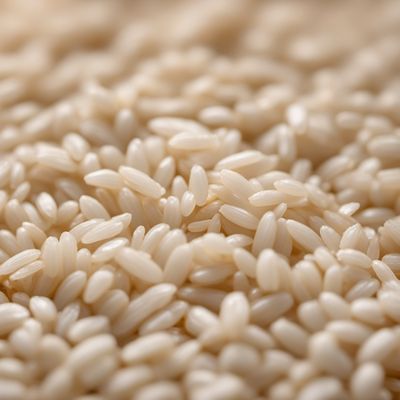
Ingredient
Rice grain, red
The Vibrant and Nutritious Red Rice Grain
Red rice grain is a whole grain rice variety with a distinctive reddish-brown color. It has a slightly chewy texture and a nutty flavor that sets it apart from other rice varieties. The grains are medium-sized and retain their shape well when cooked. Red rice grain is known for its nutritional benefits, as it is rich in fiber, antioxidants, and essential minerals.
Origins and history
Red rice grain has its origins in Southeast Asia, particularly in countries like Thailand, India, and Sri Lanka. It has been cultivated for centuries and holds cultural significance in these regions. Red rice grain is often associated with traditional and festive dishes, and its consumption dates back to ancient times.
Nutritional information
Red rice grain is a nutritious choice, as it is high in fiber, providing about 3 grams per cooked cup. It also contains essential minerals like magnesium, phosphorus, and manganese. Additionally, red rice grain is a good source of antioxidants, which help protect the body against oxidative stress.
Allergens
Red rice grain does not contain any known allergens.
How to select
When selecting red rice grain, look for grains that are unbroken, with a vibrant red color. Avoid any packages with signs of moisture or insect damage. Opt for organic or locally sourced varieties whenever possible.
Storage recommendations
To maintain the freshness and quality of red rice grain, store it in an airtight container in a cool, dry place. Avoid exposure to sunlight or moisture, as it can lead to spoilage. Properly stored, red rice grain can last for up to 6 months.
How to produce
Red rice grain can be produced by growing specific varieties of rice that naturally have a reddish hue. It requires proper soil conditions, adequate water supply, and careful cultivation techniques. However, producing red rice grain is best left to experienced farmers or agricultural experts.
Preparation tips
Before cooking red rice grain, rinse it thoroughly under cold water to remove any excess starch. For every cup of red rice grain, use 2 cups of water or broth. Bring to a boil, then reduce the heat and simmer for about 40-45 minutes, or until the grains are tender. Red rice grain can be used as a base for pilafs, salads, stir-fries, or even as a side dish on its own.
Substitutions
Brown rice or wild rice can be used as substitutes for red rice grain, as they share similar nutty flavors and textures.
Culinary uses
Red rice grain is commonly used in various dishes, such as salads, pilafs, and side dishes. It adds a vibrant color and a unique flavor to these preparations. It can also be used in stuffed vegetables or incorporated into risottos for an interesting twist.
Availability
Red rice grain is commonly available in Southeast Asian countries like Thailand, India, and Sri Lanka. It can also be found in specialty grocery stores or online retailers that offer a wide range of rice varieties.
More ingredients from this category

Rice grain, brown
The Nutrient-Packed Grain: Brown Rice

Rice grain, mixed
The Versatile Grain

Rice grain, polished
The Shining Jewel of Grains

Rice grain, parboiled
The Golden Grain: Unlocking the Secrets of Parboiled Rice

Rice grain, glutinous
The Sticky Wonder: Unveiling the Versatility of Glutinous Rice

Rice grain, long-grain
The Elegance of Long-Grain Rice
Recipes using Rice grain, red

Peranakan-inspired Tricolore Risotto
Nyonya Fusion Risotto: A Harmony of Colors and Flavors

Fusion Red Rice Delight
Harmony of Flavors: Fusion Red Rice Delight

Oaxacan-style Red Rice with Gac Seeds
Fiery Red Rice Delight with a Touch of Oaxaca

Denningvleis with Yellow Rice
Spiced Lamb Stew with Fragrant Yellow Rice

Bhutanese-inspired Kostelske Hrge
Spiced Delight: Bhutanese-inspired Kostelske Hrge

Guamanian-style Loaded Baked Potatoes
Pacific Island Delight: Guamanian Kumpir

Arganak Bhutanese Style
Spiced Bhutanese Chicken Stew with Aromatic Rice

Danish-inspired Red Rice Delight
Nordic Fusion: A Danish Twist on Red Rice